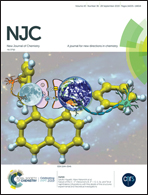Liquid phase reduction synthesis of a cobalt boride–activated carbon composite with improved specific capacitance and retention rate as a new positive electrode material for supercapacitors†
Abstract
Transition metal compounds have a high theoretical capacity, and thus they are also promising candidates for application as supercapacitors. In this work, a cobalt boride–activated carbon composite has been synthesized and applied as an electrode material of a supercapacitor for the first time. The cobalt boride–carbon composite was prepared using activated carbon (AC) as an additive and cobalt dichloride/sodium borohydride as starting materials. The addition of a small amount of activated carbon greatly improved the electrochemical performance of cobalt boride. By compositing cobalt boride with AC, the challenge of the low electrical conductivity of CoB can be addressed. In a 6 M KOH alkaline aqueous electrolyte, CoB–AC was used as the positive electrode material for an asymmetric supercapacitor (ASC) in order to carry out the electrochemical test. At 0.5 A g−1, compared with the bare cobalt boride, introducing activated carbon could increase the specific capacitance by 49.5%, up to 193.64 C g−1. Furthermore, an asymmetric supercapacitor was prepared, utilizing positive CoB–AC and negative activated carbon, respectively. The electrochemical behaviors of the prepared asymmetric supercapacitor were evaluated by cyclic voltammetry, alternating current impedance, and galvanostatic charge–discharge techniques. This showed a wide potential window of 1.6 V and after 10 000 charge/discharge cycles, an outstanding cycling stability retention rate of 80% was maintained at 2 A g−1. The as-fabricated ASC device could achieve a maximum energy density of 19.14 W h kg−1 at a power density of 200.59 W kg−1. We hope that our present work will provide a new solution for designing high specific capacity supercapacitors.



 Please wait while we load your content...
Please wait while we load your content...